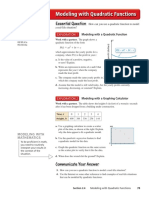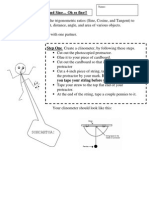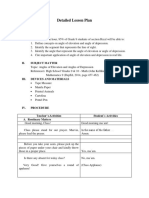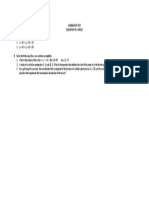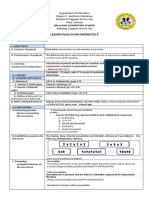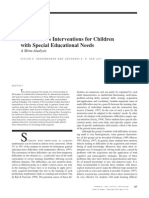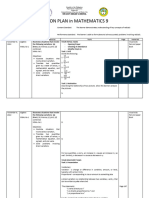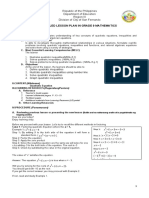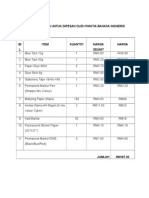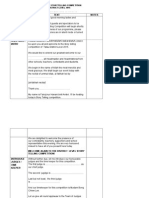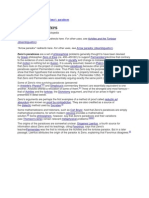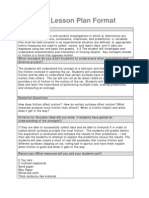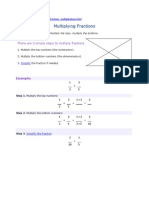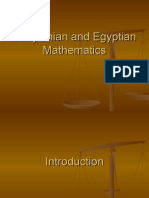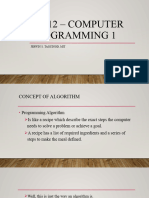Corrective Math Common Problems
Corrective Math Common Problems
Uploaded by
missfhCopyright:
Available Formats
Corrective Math Common Problems
Corrective Math Common Problems
Uploaded by
missfhCopyright
Available Formats
Share this document
Did you find this document useful?
Is this content inappropriate?
Copyright:
Available Formats
Corrective Math Common Problems
Corrective Math Common Problems
Uploaded by
missfhCopyright:
Available Formats
Common Problems Experienced by Struggling Students
Students in need of remediation often exhibit similar problems. Corrective Mathematics provides
the careful teaching and systematic practice that creates steady, measurable progress.
Learn more about five problems struggling students face and how Corrective Mathematics helps
them overcome the difficulties that they have had with mathematics.
Memorization of the basic number facts
Standard algorithms
Over reliance on estimation
Mathematical reasoning and problem-solving competency
Understanding of fractions
Corrective Math 2005 Copyright SRA/McGraw-Hill. All rights reserved.
Common ProblemMemorization of the Basic Number Facts
Common Problem How Corrective Mathematics Addresses It
Memorization of the Basic Number Facts
Memorizing the basic number facts, i.e., the sums and prod-
ucts of single-digit numbers and the equivalent subtraction and
division facts, frees up working memory to master the arithme-
tic algorisms and tackle math applications. Research in cogni-
tive psychology points to the value of automatic recall of the
basic facts. Students who do not memorize the basic number
facts will founder as more complex operations are required, and
their progress will likely grind to a halt by the end of elemen-
tary school. There is no real mathematical fluency without
memorization of the most basic facts.
The State of State Math Standards
Corrective Mathematics promotes a high level of student
proficiency by teaching each fact as a member of both a
number family and a fact series, rather than separate entities to
be memorized.
Number families consist of three numbers that go together
to form a basic fact. In Addition and Subtraction, students
work with number families that look like this:
4 + 1 = 5
1 + 4 = 5
5 1 = 4
5 4 = 1
Learning number families is instructionally economical because
each number family translates into four facts.
Fact Series exercises present facts in order to show their
relationship to counting. For example:
6 + 1 = 7
6 + 2 = 8
6 + 3 = 9
Every time a number is counted in the second addend (1, 2, 3),
the number is counted in the sum (7, 8, 9). By teaching fact
relationships, individual facts are easier to recall.
Once students have a number of firm reference points and
know how to use these reference points to figure out
closely related facts, the modules provide a number of ex-
ercises designed to increase proficiency and automaticity
with individual facts, including Fact Games in which
groups of students compete, the Timing Format in which
individual students earn points, and Blackline Masters for
optional facts practice.
Special fact relationships usually omitted in instructional
programs are taught. For example, division facts are taught
in most programs, but not division remainder facts. In
Corrective Mathematics students are taught 5 goes into 30
six times and also that 5 goes into 31, 32, 33, and 34
six times.
Corrective Math 2005 Copyright SRA/McGraw-Hill. All rights reserved.
Common ProblemThe Standard Algorithms
Common Problem How Corrective Mathematics Addresses It
The Standard Algorithms
The standard algorithms are powerful theorems and they are
standard for a good reason: They are guaranteed to work for
all problems of the type for which they were designed. Know-
ing the standard algorithms, in the sense of being able to use
them, is a foundational skill for an elementary schools students.
Students who master these algorithms gain confidence in their
ability to compute. They know they can solve any addition,
subtraction, multiplication, or division problem without relying
on a mysterious black box, such as a calculator. Moreover, the
ability to execute the arithmetic operations in a routine manner
helps student to think more conceptually and are well posi-
tioned to understand the meaning and uses of other algorithms
in later years.
For example, one benefit of the long division algorithm is that it
requires estimation of quotients at each stage. If the next digit
placed in the (trial) answer is too large or too small, that stage
has to be done over again, and the error is made visible by the
procedure. Number sense and estimation skills are reinforced
in this way.
The long division algorithm has applications that go far beyond
elementary school arithmetic. At the middle school level, it can
be used to explain why rational numbers have repeating deci-
mals. Division is also central to the Euclidean Algorithm for
the calculation of the common divisor or two integers. In high
school algebra, the long division algorithm, in a modified form,
is used for division of polynomials. At the university level, the
algorithm is important in advanced abstract algebra.
Experience with the long division algorithm thus lays the
groundwork for advanced topics in mathematics.
The State of State Math Standards
Corrective Mathematics teaches coherent routines that allow
students to handle a wide variety of computation problems.
Routines provide for all the various types of problems that stu-
dents might encounter, such as borrowing from zero in subtrac-
tion and multiplying by a number with a zero in the ones col-
umn.
Instruction is carefully sequenced and strongly scaffolded so
that students learn all necessary components skills
(preskills) prior to the introduction of the routine and can
apply steps they are to follow in using a routine.
For example:
The division operation is first introduced for single-digit divisor
problems. Students underline the part of the dividend that is at
least as big as the divisor. Next, they work the underlined prob-
lem and find the remainder for that part. Then they bring down
the next digit and work the new problem in the same way. They
continue in this manner until they have written a number above
the last digit of the dividend. This signals that the problem is
finished.
The single-digit divisor strategy is first shown with problems
that have one- and 2-digit answers. Early problems do not have
answers with zeros. Later problems present 3-digit answers,
answers with zero in the middle, and answers with zero as the
final digit. Special exercises focus on these troublesome types
of division problems.
For 2-digit divisors, the procedure is the same as that for
single-digit divisors, except the students round off the divi-
sor and the underlined part of the problem to the nearest tens
number. For example, if the problem is , students
write the rounded-off problem as . The rounding-off
sometimes leads to trial answers that either too large or too
small. Students are taught to determine whether the remain-
der is too large, and if it is, to make the answer larger. If the
remainder is too small (a negative number), students make
the answer smaller. By the end of the module, students can
solve problem of these types:
63 483
6 48
44 5900 24 2165
34 3618 75 3052
Corrective Math 2005 Copyright SRA/McGraw-Hill. All rights reserved.
Common ProblemOver Reliance on Estimation at the Expense of
Exact Arithmetic Calculations
Common Problem How Corrective Mathematics Addresses It
Over reliance on estimation at the expense of exact arithmetic
calculations
Fostering estimation skills is a commendable goal shared by all
math programs. However, there is a tendency to overempha-
size estimation at the expense of exact arithmetic calculations.
For simple subtraction, the correct answer is the only reason-
able answer. The notion of reasonableness might be appro-
priate in connection with measurement, but not in connection
with arithmetic of small whole numbers. The main goal of ele-
mentary school math is to get students to think about numbers
and to learn arithmetic. Hand calculations force students to
develop an intuitive understanding of place value and of frac-
tions.
The State of State Math Standards
Corrective Mathematics teaches arithmetic calculations through
carefully sequenced and strongly scaffolded lessons.
The care with which each necessary preskill is introduced is
well demonstrated by the operations activities in the Subtrac-
tion module. Before the students learn the routine for subtract-
ing with borrowing in one column, they master these preskills:
Rewriting numbers by borrowing. Given a number with
one digit slashed, the students learn to borrow from the
slashed digit. The students write the borrowed amount in
front of the digit immediately to the right of the slashed
digit.
Given 3572
2
Students write 3
1
572
Subtracting multidigit numbers without borrowing.
Given a multidigit subtraction problem, the students learn
to subtract the bottom digit from the top digit in each col-
umn, starting with the ones column.
Given 841
410
Students begin with
the ones column
and write 841
410
431
Determining when and where to borrow. Given a partial
subtraction problem, the students learn that if youre minus-
ing more than you start with, you have to borrow. The stu-
dents use a slash mark to indicate the position of the digit they
would borrow from.
Given 2 Students write 2
7
Subtracting when borrowing has been done. Given a
problem in which borrowing has been done for the stu-
dents, the students learn to subtract accurately.
2
Given 3
1
4
18
2
Students write 3
1
4
18
1 6
Corrective Math 2005 Copyright SRA/McGraw-Hill. All rights reserved.
Common ProblemMathematical Reasoning and Problem Solving Competency
Common Problem How Corrective Mathematics Addresses It
Mathematical Reasoning and Problem-solving Competency
Problem-solving is an indispensable part of learning mathemat-
ics. Children should be able to solve single-step word problems
in the earliest grades and deal with increasingly more challeng-
ing, multi-step problems as they progress. Too often, programs
fail to develop important prerequisites before introducing ad-
vanced topics.
The State of State Math Standards
One of the major strengths of the Corrective Mathematics pro-
gram is that Corrective Mathematics teaches a precise strategy
for determining which mathematics operation is required by a
given story problema feature not typically shared by other
mathematics programs.
Although students learn in the Subtraction module that
certain verbs generally indicate whether to add (find, get,
buy) or subtract (lose, give away, break), they quickly
learn that they cannot rely solely on the verb to determine
the appropriate operation. For example, the following prob-
lem calls for addition, even though give away would seem-
ingly call for subtraction.
Bill gives away 4 toys. John gives away 2 toys. How many
toys did the boys give away?
Because using the verb to determine whether addition or
subtraction is called for is not a viable strategy for many
story problems, the Subtraction module quickly teaches
this discrimination strategy: If the problem gives the big
number, its a subtraction problem; if the problem does not
give the big number, its an addition problem. (The big
number is the minuend in a subtraction problem and the
sum is an addition problem.) The strategy is illustrated by
the following problems.
Mr. Yamada had 36 books. Last week he bought more books at
the used bookstore. Now he has 58 books. How many books did
he buy last week?
In this problem, the big number, 58, is given. Therefore,
the problem is a subtraction problem and translates into
58
36
In the second problem, the big number (how many win-
dows in all) is not given.
An office building has 2365 clean windows. The window wash-
ers have to wash 90 dirty windows. How many windows in all
does the building have?
Therefore, the problem is an addition problem and trans-
lated into
2365
+ 90
An additional strength of the Story Problems track of the mod-
ules is that the students are taught to apply their discrimination
strategies to a wide variety of problem types. Subtraction mod-
ule.
Furthermore, the specific preskills for each problem type are
carefully taught. For instance, before being presented with addi-
tion and subtraction classification problems, the students are
taught the class name for the big number. For example, in a
problem involving hammers, tools, and saws, students are
taught that tool is the name for the big number because ham-
mers are tools and saws are tools.
Corrective Math 2005 Copyright SRA/McGraw-Hill. All rights reserved.
Common ProblemFraction Development
Common Problem How Corrective Mathematics Addresses It
Fraction Development
In general, too little attention is paid to the coherent develop-
ment of fractions and there is not enough emphasis on paper-
and pencil- calculations. When fraction arithmetic is poorly
developed in the elementary grades, students have little hope of
understanding algebra as anything other than a maze of compli-
cated recipes to be memorized.
The State of State Math Standards
The development of fractions and decimals receives special
attention in Corrective Mathematics as students are guided
through a logical, coherent progression of steps.
Basic Fractions teaches what the numbers in a fraction tell.
The bottom number tells how many parts in each whole, and
the top number tells how many parts are used. In the fraction
, there are 4 parts in each whole and 3 parts are used.
Students learn the difference between parts of a whole and
an entire whole. Later they learn to tell how many wholes a
fraction equals by determining how many times bigger the top
number is than the bottom number.
The module presents visual examples of what happens
when fractions are added and worksheets provide a great
deal of practice adding and subtracting fractions with like
denominators.
Before students add and subtract fractions with unlike denomi-
nators, they learn to make the bottom numbers the same by
figuring out the fraction versions of 1 by which they must mul-
tiply each original fraction.
Students learn that equivalent fractions are created by mul-
tiplying a fraction by another fraction that equals 1. Two com-
ponents skills exercises prepare students for equivalent frac-
tion exercises.
The first component skill teaches students to identify frac-
tions that equal 1 whole: A fraction equals 1 whole when
you use the same number of parts that are in each whole.
The second component skill teaches the concept that when
you multiply by 1, you start and end with equal amounts.
The initial exercises in which students are asked to find a
missing number in an equivalent fraction are written in this
form: =
The students will write a fraction equal to 1 in the paren-
theses. The equal sign indicates that we must end with an
amount that equals the amount we start with. We must
multiply by a fraction that equals 1. Students first figure
out what number the denominator of the first fraction must
be multiplied by to end up with the denominator of the
second fraction. Five time what number equals 15? The
answer is 3. The denominator of the fraction were multi-
plying by is 3. Because we must multiply by a fraction
that equals 1, the top number must also be 3. A fraction
equals 1 when the top and the bottom numbers are the
same. The students write in parentheses and then multi-
ply the numerator of the initial fraction and the numerator
of the fraction that equals one whole. The answer is 12.
= = =
4 7 9
1
4 7 9
=
3 3
1
5 5
4
5
15
4
5
4
5
3
3
Corrective Math 2005 Copyright SRA/McGraw-Hill. All rights reserved.
You might also like
- RectangleDocument5 pagesRectangleRetchel ManguilimotanNo ratings yet
- Alg2 02 04Document8 pagesAlg2 02 04vinctor songNo ratings yet
- Laws of ExponentDocument6 pagesLaws of ExponentMeryl Fe P. GumeraNo ratings yet
- Bar Model Math LessonDocument7 pagesBar Model Math Lessonapi-301426684No ratings yet
- LUSD Whole Group Lesson Design TemplateDocument2 pagesLUSD Whole Group Lesson Design TemplateJuanNo ratings yet
- MODULE 2 - Factoring Polynomials (Part II)Document12 pagesMODULE 2 - Factoring Polynomials (Part II)Dexter CarpioNo ratings yet
- 18 Probability Part 1 of 3Document19 pages18 Probability Part 1 of 3Phani KumarNo ratings yet
- Trigonometry Project Information SheetDocument7 pagesTrigonometry Project Information Sheetapi-261139685No ratings yet
- The Sum and Product of Roots (Day 3&4)Document15 pagesThe Sum and Product of Roots (Day 3&4)Aíméé CúràyNo ratings yet
- MTAP Team Orals Division Level 2017Document2 pagesMTAP Team Orals Division Level 2017GraceNo ratings yet
- Table of SpecificationDocument1 pageTable of SpecificationAngelica Manalo PerezNo ratings yet
- Detailed Lesson PlanDocument11 pagesDetailed Lesson PlanRuiben Rey Padero PaulinoNo ratings yet
- SUMMATIVE - m10 - EQUATION OF A CIRCLEDocument1 pageSUMMATIVE - m10 - EQUATION OF A CIRCLECeleste CelestineNo ratings yet
- Distance Formula For CODocument14 pagesDistance Formula For CORechelle MollanidaNo ratings yet
- Lesson Plan Rat DenomDocument1 pageLesson Plan Rat DenomJonathan RobinsonNo ratings yet
- Graphing Polynomials Lesson Plan and MaterialsDocument8 pagesGraphing Polynomials Lesson Plan and MaterialsDiana Janica MagalongNo ratings yet
- Distance FormulaDocument16 pagesDistance FormulaAngelie OctavioNo ratings yet
- School Grade Level Teacher Learning Area Time & Dates Quarter I. ObjectivesDocument4 pagesSchool Grade Level Teacher Learning Area Time & Dates Quarter I. Objectivesoszel june balanayNo ratings yet
- Time Allotment in Each Step) : Teacher's Activity Student's ActivityDocument1 pageTime Allotment in Each Step) : Teacher's Activity Student's ActivityJerson YhuwelNo ratings yet
- Sim MathDocument21 pagesSim MathRegin BaguioNo ratings yet
- Permutation: Thomas F. Valencia ReporterDocument15 pagesPermutation: Thomas F. Valencia ReporterThomas ValenciaNo ratings yet
- Using Distance Between Two Points and The Pythagorean TheoremDocument2 pagesUsing Distance Between Two Points and The Pythagorean TheoremLauren EricksonNo ratings yet
- Rational Numbers Presentation 7th GradeDocument8 pagesRational Numbers Presentation 7th Gradewissam FermasefNo ratings yet
- Lesson Plan Omer Baktir 1Document10 pagesLesson Plan Omer Baktir 1api-501227468No ratings yet
- DLL Math 10 Q2 D5Document8 pagesDLL Math 10 Q2 D5Carmina DuldulaoNo ratings yet
- Lesson Plan in Mathematics 6: Balulang Elementary SchoolDocument3 pagesLesson Plan in Mathematics 6: Balulang Elementary SchoolJENNESSA VERULANo ratings yet
- Lesson Plan - Applications of Right TrianglesDocument2 pagesLesson Plan - Applications of Right Trianglesapi-448318028No ratings yet
- Jan 4-9 Distance FormulaDocument7 pagesJan 4-9 Distance Formulaaimeejane.pamplonaNo ratings yet
- Dll-Math Inset 2023 - TuazonDocument3 pagesDll-Math Inset 2023 - TuazonJonel TuazonNo ratings yet
- Cup 1 Cup 2: RED REDDocument4 pagesCup 1 Cup 2: RED REDRenel MapindanNo ratings yet
- 3c. Prove Theorems About Parallelograms Lesson PlanDocument2 pages3c. Prove Theorems About Parallelograms Lesson PlanDhingcoi Czc Allado AducalNo ratings yet
- Lesson Plan The Pythagorean TheoremDocument6 pagesLesson Plan The Pythagorean Theoremmcook9171No ratings yet
- Session 5 - Decision Making Numeracy Assessment Test Results Interpretation and DisseminationDocument70 pagesSession 5 - Decision Making Numeracy Assessment Test Results Interpretation and Disseminationguillermo desaculaNo ratings yet
- Mathematics Intervention For Children With Special Educational Needs Kroesbergen en Van Luit 2003 PDFDocument19 pagesMathematics Intervention For Children With Special Educational Needs Kroesbergen en Van Luit 2003 PDFkaskaraitNo ratings yet
- SIM (Rational Numbers)Document26 pagesSIM (Rational Numbers)Charlene Sallan Galvez100% (1)
- Lesson PlanDocument6 pagesLesson PlanVanessa Pangan Keller100% (1)
- LP With ANNOTATIONS-Q3 Union & Intersection of EventsDocument6 pagesLP With ANNOTATIONS-Q3 Union & Intersection of EventsMa Candie Edep CamachoNo ratings yet
- DLL For Law-Of-SineDocument6 pagesDLL For Law-Of-SineRotshen CasilacNo ratings yet
- S CP A 3 Lesson Conditional ProbabilityDocument4 pagesS CP A 3 Lesson Conditional ProbabilityNico Viñas ValeraNo ratings yet
- Lesson PlanDocument6 pagesLesson PlanacirultraNo ratings yet
- Daily Lesson LogDocument152 pagesDaily Lesson LogJoel VelasquezNo ratings yet
- Quarter 1-Week 2-Lesson 2 Arithmetic Sequences, Means and SeriesDocument5 pagesQuarter 1-Week 2-Lesson 2 Arithmetic Sequences, Means and SeriesMica Ella Olivar100% (1)
- PROGRAM Matematika IsusulongDocument4 pagesPROGRAM Matematika IsusulongRoselyn Catubig Vidad JumadlaNo ratings yet
- 16.illustrate Systems of Linear EquationsDocument3 pages16.illustrate Systems of Linear EquationsMiriam Galicia100% (1)
- Q1W2 M9 - Solving Quadratic Equation by Extracting Square RootsDocument15 pagesQ1W2 M9 - Solving Quadratic Equation by Extracting Square RootsMarjorie PeralesNo ratings yet
- Lessonplaninmathematics10permutations 1Document2 pagesLessonplaninmathematics10permutations 1Edwin SartinNo ratings yet
- Ubd Final MathDocument6 pagesUbd Final Mathapi-296454132No ratings yet
- Quadratic Function Test ReviewDocument3 pagesQuadratic Function Test ReviewWeteachNo ratings yet
- Q2 - DLL-De Leon - November 21 - 25, 2022Document7 pagesQ2 - DLL-De Leon - November 21 - 25, 2022Cipriano De LeonNo ratings yet
- m201 Math Lesson Plan 4 1Document4 pagesm201 Math Lesson Plan 4 1api-384966224No ratings yet
- Math Vocabulary Grade6Document12 pagesMath Vocabulary Grade6Mariana HillNo ratings yet
- Lesson Plan - Simiarities of TriangleDocument3 pagesLesson Plan - Simiarities of TriangleCris JanNo ratings yet
- Topic - Probability of Dependen Event PPT 2Document20 pagesTopic - Probability of Dependen Event PPT 2Madona T. VillanuevaNo ratings yet
- Module4 Complex Rational ExpressionsDocument6 pagesModule4 Complex Rational ExpressionsAlbert BalingitNo ratings yet
- Detailed Lesson Plan in Grade 9 MathematicsDocument10 pagesDetailed Lesson Plan in Grade 9 MathematicsPaul John TasicNo ratings yet
- Mini Lesson Plan-ExponentialsDocument5 pagesMini Lesson Plan-Exponentialsapi-301980453No ratings yet
- 01 Teaching NotesDocument7 pages01 Teaching Notesfatcat7294.01No ratings yet
- Grade 4 Sorico Math Unit 1 2 2013-2014Document4 pagesGrade 4 Sorico Math Unit 1 2 2013-2014api-233707670100% (1)
- Grade 3, Unit Two: Place Value Structures & Multi-Digit ComputationDocument2 pagesGrade 3, Unit Two: Place Value Structures & Multi-Digit ComputationMeganMaynardNo ratings yet
- Unit 1 NotebookDocument28 pagesUnit 1 Notebookapi-256798980No ratings yet
- Senarai Order BRG Panitia BiDocument1 pageSenarai Order BRG Panitia BimissfhNo ratings yet
- Teks MC Story TellingDocument6 pagesTeks MC Story Tellingmissfh100% (2)
- Paradoks ZenoDocument43 pagesParadoks ZenomissfhNo ratings yet
- Friction ModuleDocument23 pagesFriction ModulemissfhNo ratings yet
- Cornellius Maling Rangga Amas Nasha Ujai Nyalong Abak Jenet Alexson Winnie Charity Lucia Mawas Immanuel Mark Mira Jati Dessy Menah Sophia ShahrinaDocument1 pageCornellius Maling Rangga Amas Nasha Ujai Nyalong Abak Jenet Alexson Winnie Charity Lucia Mawas Immanuel Mark Mira Jati Dessy Menah Sophia ShahrinamissfhNo ratings yet
- Friction ModuleDocument23 pagesFriction ModulemissfhNo ratings yet
- Menurut LimDocument3 pagesMenurut LimmissfhNo ratings yet
- Bowling Averages: Super Teacher WorksheetsDocument2 pagesBowling Averages: Super Teacher WorksheetsmissfhNo ratings yet
- Multiplying Fractions: There Are 3 Simple Steps To Multiply FractionsDocument3 pagesMultiplying Fractions: There Are 3 Simple Steps To Multiply FractionsmissfhNo ratings yet
- Lecture 2 - Speech OrgansDocument13 pagesLecture 2 - Speech OrgansmissfhNo ratings yet
- 21 Adding and Subtracting Decimals: Part 1Document7 pages21 Adding and Subtracting Decimals: Part 1missfhNo ratings yet
- Misconceptions Error 2Document40 pagesMisconceptions Error 2missfhNo ratings yet
- Math 7 CH 2.2 p60Document5 pagesMath 7 CH 2.2 p60missfhNo ratings yet
- Babylonian and Egyptian MathematicsDocument15 pagesBabylonian and Egyptian MathematicsmissfhNo ratings yet
- Another Reading Strategy Is To Answer The Questions That Form The Basis of Good Journalism: Who What When Where Why and HowDocument1 pageAnother Reading Strategy Is To Answer The Questions That Form The Basis of Good Journalism: Who What When Where Why and HowmissfhNo ratings yet
- Assignment of Fundamental of Computer (Vicky)Document16 pagesAssignment of Fundamental of Computer (Vicky)Vicky Gadhia90% (10)
- FUNDAMENTALS OF ARTIFICIAL INTELLIGENCE AND DEEP LEARNING TECHNIQUES Ijariie12362 PDFDocument5 pagesFUNDAMENTALS OF ARTIFICIAL INTELLIGENCE AND DEEP LEARNING TECHNIQUES Ijariie12362 PDFJabeer Abdul SatharNo ratings yet
- PsuedocodesDocument8 pagesPsuedocodesJawwad Saeed KhanNo ratings yet
- GE6151 Computer Programming NotesDocument152 pagesGE6151 Computer Programming NotesSuryaNo ratings yet
- Wealth of Programming ChallengesDocument6 pagesWealth of Programming ChallengesAnkur MadaanNo ratings yet
- 1 Algorithm PracticeDocument4 pages1 Algorithm PracticeAtharv HalmadgeNo ratings yet
- Cambridge International AS & A Level: Computer Science 9618/22Document20 pagesCambridge International AS & A Level: Computer Science 9618/22Shanbhavi ShanmugarajahNo ratings yet
- Introduction To Data StructureDocument7 pagesIntroduction To Data StructureademolaNo ratings yet
- SC025 praPSPM Set A (Answerscheme)Document11 pagesSC025 praPSPM Set A (Answerscheme)SYAFIQAH BATRISYIA MOHD ZAHIRNo ratings yet
- BCOL306 Design & Analysis of Algorithm: Course ObjectivesDocument44 pagesBCOL306 Design & Analysis of Algorithm: Course ObjectivesShruti patilNo ratings yet
- Design of Plural-Multiplier Based On CORDIC Algorithm For FFT ApplicationDocument3 pagesDesign of Plural-Multiplier Based On CORDIC Algorithm For FFT ApplicationNsrc Nano ScientifcNo ratings yet
- CST 402 - Distributed ComputingDocument78 pagesCST 402 - Distributed ComputingNiya SebastianNo ratings yet
- Floating Labels: Applying Dynamic Potential Fields For Label LayoutDocument13 pagesFloating Labels: Applying Dynamic Potential Fields For Label LayoutHassan AhmedNo ratings yet
- Programming Methodologies - Quick Guide - TutorialspointDocument25 pagesProgramming Methodologies - Quick Guide - TutorialspointMc Gemrick SantosNo ratings yet
- Module EnglishDocument284 pagesModule Englishtanmaya1991No ratings yet
- DIRECT Optimization Algorithm User GuideDocument14 pagesDIRECT Optimization Algorithm User GuideMostafa MangalNo ratings yet
- 01 02 Algorithms AssessmentDocument3 pages01 02 Algorithms Assessmentanshi christinaNo ratings yet
- A Library of Optimization Algorithms For Organizational DesignDocument40 pagesA Library of Optimization Algorithms For Organizational DesignKoleman KoolerNo ratings yet
- Optimal Design of Shell and Tube Heat Exchanger Using Genetic AlgorithmsDocument6 pagesOptimal Design of Shell and Tube Heat Exchanger Using Genetic AlgorithmssaravananNo ratings yet
- Multiple Element Contingency Screening: C. Matthew Davis, Member, IEEE, and Thomas J. Overbye, Fellow, IEEEDocument8 pagesMultiple Element Contingency Screening: C. Matthew Davis, Member, IEEE, and Thomas J. Overbye, Fellow, IEEEVitthal PatnechaNo ratings yet
- IT 112 - Computer Programming 1Document21 pagesIT 112 - Computer Programming 1Jerwin TaguinodNo ratings yet
- Barcode Recognition System (Second Seminar)Document13 pagesBarcode Recognition System (Second Seminar)Alex WunnaNo ratings yet
- Outline of New Approach To The Analysis of Complex Systems and Decision ProcessesDocument17 pagesOutline of New Approach To The Analysis of Complex Systems and Decision ProcessesEKS VIDEOSNo ratings yet
- Genetic Approach Time Table Generator - A Case StudyDocument6 pagesGenetic Approach Time Table Generator - A Case StudyNeoElfeoNo ratings yet
- DaaDocument39 pagesDaaVijay KumarNo ratings yet
- Computer Concepts and C Language: - Prof. Niranjan N.ChiplunkarDocument5 pagesComputer Concepts and C Language: - Prof. Niranjan N.ChiplunkarGebBerheNo ratings yet
- FAL (2019-20) - CSE1004 - ELA - 119 - AP2019201000445 - Reference Material I - Week-1-2Document32 pagesFAL (2019-20) - CSE1004 - ELA - 119 - AP2019201000445 - Reference Material I - Week-1-2abhay chaudharyNo ratings yet
- MTH 136fall2021 SyllabusDocument6 pagesMTH 136fall2021 SyllabusEdgar ChisholmNo ratings yet
- Pseudo Code Presentation PDFDocument26 pagesPseudo Code Presentation PDFSimon SimuntalaNo ratings yet
- Template Jurnal JAMNDocument3 pagesTemplate Jurnal JAMNMarista Winanti SutadiprajaNo ratings yet

